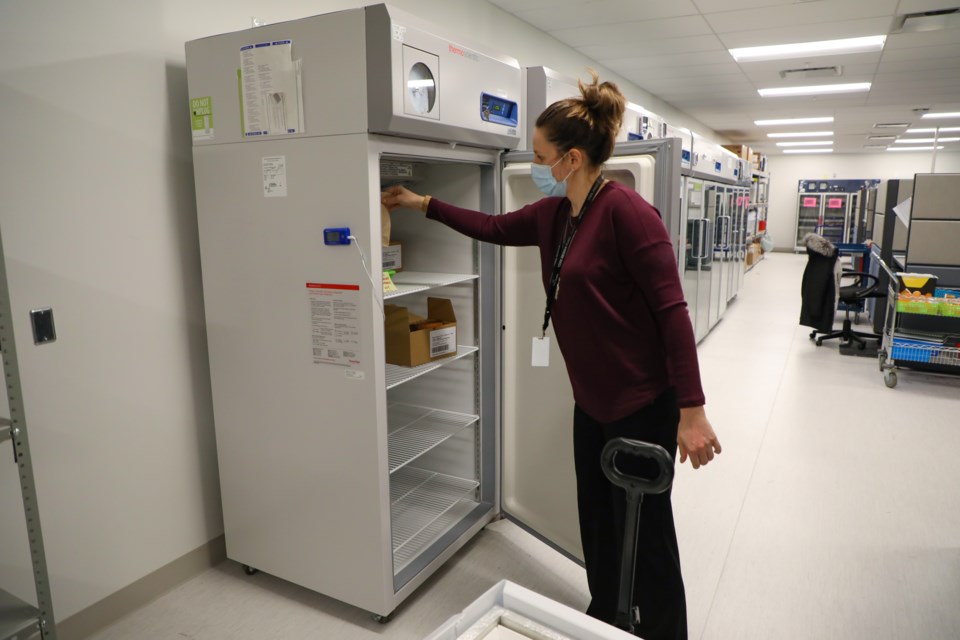In a case of impeccable timing, York Region Public Health's new vaccine depot was completed just in time for the most important vaccine distribution effort in living memory.
The 2,170-square-foot facility at an undisclosed location was completed last August and was originally intended for use with flu vaccines.
But according to infectious disease control manager Gerald Tan, having a state-of-the-art facility for the past four months has been a major benefit during the first major global pandemic in a century. This is especially true since some of the COVID-19 vaccines require special storage and logistical requirements.
"The new vaccine depot is purpose-built for its function and incorporates a design that enables ergonomic picking and packing of vaccines. It provides access to a loading dock where the refrigerated vaccine van is loaded to deliver vaccines to sub-office distribution points for health-care providers," said Tan.
"Health-care providers come to pick up vaccines at the Access York counters, which are also equipped with vaccine fridges; unfortunately, some of these efficiency gains are compromised currently due to COVID-19," he added.
To date, a total of 9,000 doses of the Moderna vaccine have been received, with 600 doses received Jan. 15, in addition to the earlier shipment of 8,400 doses received on Dec. 31. Most of the doses — 6,810 — have been distributed to York Region's long-term care and retirement homes.
The vaccine depot is nearly twice as large as its predecessor and has equipment such as temperature-monitored vaccine refrigeration units, a walk-in cooler on a loading dock, specialized vaccine fridges provided by the Ministry of Health, and electrically insulated containers for transporting the vaccines.
Specialized staff at the depot include:
- 11 pharmacy technicians who order and process vaccines, and manage the overall inventory, ensure they are kept cold during distribution, investigate storage problems, and help support the health-care providers.
- 1 public health pharmacist who provides clinical support, makes sure that vaccines go to high-risk people, and maintains stability data
- 1 pharmaceutical inventory assistant who prepares the coolers, packs the vaccines for delivery and drives them to wherever they are needed.
- 1 administrative clerk who maintains records and keeps the office stocked with supplies
- 1 vaccine inventory manager who oversees the whole operation of processing and distributing the vaccines to make sure everything is following provincial standards and meets the community's needs.
According to Tan, staff rotate between roles such as answering calls and emails from clients and health-care providers, reviewing orders, reviewing the accuracy of orders, and taking the vaccines out of storage to be packed.
But even the vaccine depot has been impacted by the new restrictions under the state of emergency, particularly the restriction on gatherings.
"Currently, like any workplace, there are COVID-19 restrictions on number of staff that can work safely in the space provided," he said.
"Since we work with a physical product in vaccines, our staff is unable to work remotely. Additional precautions are in place to ensure the staff is able to work safely and effectively."
So what happens to a vaccine from the time it arrives at the depot until it ends up in someone's arm in York Region?
According to Tan, when vaccines arrive they are first placed temporarily in the walk-in fridge on the loading dock.
"Vaccines must be maintained at cool or cold temperatures in order to maintain effectiveness," he said.
After that, they are taken to the vaccine fridges, the temperature of which is monitored at all times.
Health-care providers send in orders for vaccine doses by either email or fax to the depot. Those orders also include temperature logs from their own fridges to prove they can store the doses correctly.
Orders are scrutinized to make sure that health-care providers will only have one month's worth of doses on-hand at any given time. This is to prevent over-ordering and potential waste.
The order is then entered into a provincial database called Panorama, which is used to track vaccine inventory across Ontario.
Only then are the ordered vaccines removed from the depot's fridge's and packed into the transportation coolers. The courier then transports them in a refrigerated van to one of five distribution locations in Newmarket, Markham, Richmond Hill, Vaughan and Georgina.
When they reach one of those distribution locations, they are put in another vaccine fridge while the health-care providers are called to tell them their order is ready to be picked up. When they come to get the doses, York Region staff make sure the transport cooler is at the right temperature before handing them over.
The health-care providers then take the vaccines and place them in their own fridges at their facilities. Once there, they can be prepared and used to inoculate people.



